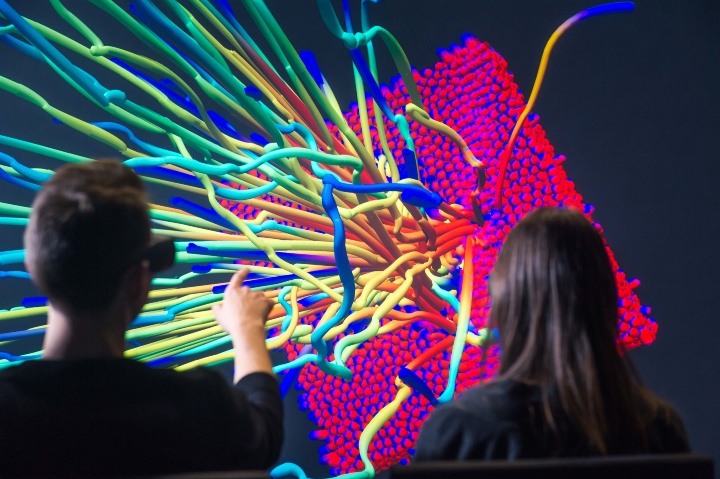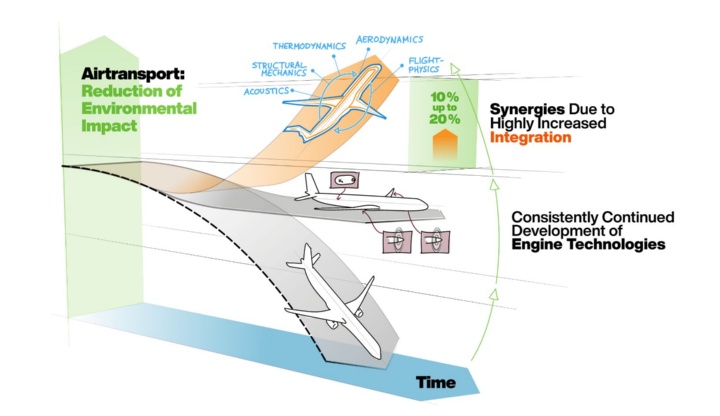At its meeting on May 17, 2023, the German Research Foundation (DFG) extended funding for the transregional collaborative research center CRC-TRR 161 “Quantitative Methods for Visual Computing” (spokesperson Prof. Daniel Weiskopf, Visualization Research Center of the University of Stuttgart) for another four years. This means that three CRCs and two transregional CRCs with speakerships are located at the University of Stuttgart. CRC-TRR 364 “SynTrac” (speakership: TU Braunschweig) in which the University of Stuttgart is also involved was newly approved.
Prof. Wolfram Ressel, Rector of the University of Stuttgart, is quite pleased with the decision of the DFG. “The approval of the two transregional CRCs is a great achievement for the University of Stuttgart and gives us a huge boost for the excellence strategy that is starting up. Collaborative research centers and transregional collaborative research centers are flagships of the German scientific landscape and enable our excellent researchers to work on innovative, challenging, and long-term research projects. The current decision of the DFG makes a major contribution to our ability to continue to devote ourselves to important topics of the future together with our partner institutes. Both projects – visual computing and highly integrated aircraft development – clearly contribute to actively shaping the (digital) world of tomorrow.”
CRC-TR 161 “Quantitative Methods for Visual Computing”, Spokesperson
CRC-TR 161 aims to facilitate the handling of ever growing amounts of information. Among other things, the researchers are investigating the quality and applicability of computer-based methods for visualizing data in order to customize them. The collaborative project is sponsored by the universities of Stuttgart and Konstanz. The Ludwig-Maximilian University of Munich and the University of Ulm are also involved. SFB-TRR 161 is entering its third funding period and has a volume of EUR 8 million over four years.
Visual computing (i.e., the computer-aided processing and display of image information) is used in numerous applications in research, industry, and the private sector (e.g., the visualization of measurement data or simulations, virtual maps and tours, and analysis tools for the medical sector). “CRC-TR 161 brings together experts from the various fields needed for visual computing,” says spokesperson Prof. Daniel Weiskopf. “The results of the first two funding periods demonstrate the overwhelming success of this collaboration. We have contributed to the national and international development of the field and advanced visual computing techniques and their application.”
For example, the 50 or so scientists involved in the joint project have researched how special procedures can be used to reduce the risk of cyber-sickness (i.e., the fatigue and nausea experience after prolonged use of virtual reality). They also investigated what conditions are necessary to combine displays held in the hand by users with devices worn on the head (e.g., VR or AR goggles). The methods developed in CRC-TR 161 were also used in applications for automatically drawing subway maps or researching the collective behavior of cheetahs.
In the third funding period, CRC-TR 161 aims to further improve the methods and approaches developed so far and to integrate them into various applications. Building on the findings from the first two funding periods and current developments, the scientists would also like to devote more attention to new research questions. “In the last four years, for example, immersion has had a big influence on our research. We would therefore like to further expand the area and make mixed reality applications a focus in the third funding period,” says vice speaker Prof. Falk Schreiber from the University of Konstanz. “We will also be looking more closely at how well users understand the phenomena when presented visually.”
CRC-TR 364 “Synergies of Highly Integrated Transport Aircraft” (SynTrac)
In order to set the course for climate-neutral air traffic, not only the engines but also the aircraft themselves and their components must be optimized. A high degree of integrated functions and components can reduce weight, size, and energy consumption while increasing performance and efficiency. But just how big are these effects? What potential can be realized? And what are the synergy effects of highly integrated transport aircraft? Researchers in the collaborative research center/transregional project “Synergies of Highly Integrated Transport Aircraft” (SynTrac) are looking into these very questions. Under the leadership of the Technical University of Braunschweig together with the University of Stuttgart, the Leibniz University of Hanover and the German Aerospace Center (DLR), this project will be funded by the German Research Foundation (DFG) from October 1, 2023 – initially for three years and nine months.
Against the backdrop of the Paris Climate Agreement and the European Green Deal, which call for a 50% reduction in aircraft energy consumption by 2035, researchers are looking for ways to increase the overall efficiency of aircraft. In various sub-projects, they are exploring the synergies and potentials of highly integrated aircraft development. Taking a multidisciplinary and cross-systems view of aircraft development, they use the interactions of aerodynamics, acoustics, flight physics, structural mechanics, and thermodynamics in order to develop future highly efficient aircraft through innovative approaches.
One focus of SynTrac is the integration of the drive into the airframe. This offers new opportunities for cross-system optimization and function integration. This high degree of integration results in a high level of complexity (e.g., in the design of components and in construction). In cross-disciplinary teams, the researchers will first examine the most important interdependent physical processes in the aircraft, what influence they have on the environment, and how well they can be integrated. They will then examine how new synergies can result from merging or combining functions and how great the synergy effect ultimately is. The synergies will be used in aircraft design, acoustics, and aero- and thermodynamics, among other things.
“With the new collaborative research center on aviation, we are building on years of cooperation with the University of Stuttgart. Two locations of aeronautics research are now joining forces in order to create the basis for exploiting significant potentials required for sustainability in aeronautics,” says Prof. Sabine C.Langer, spokesperson of the collaborative research center.
“In SynTrac, we conduct research at the interfaces of disciplines and components. In this way, we will not only gain new insights but also train a new generation of engineers, who will then be able to turn the associated potential into future products,” says Prof. Stephan Staudacher, co-spokesman of the collaborative research center.
Expert Contact:
CRC-TR 161 „Quantitative Methoden für Visual Computing“, Spokesperson Prof. Daniel Weiskopf, University of Stuttgart, Visualization Research Center, Tel. +49 711 685 88602, E-Mail
CRC-TR 364 „Synergies of Highly Integrated Transport Aircraft“ (SynTrac), Spokesperson Prof. Sabine Christine Langer, TU Braunschweig, Co-spokesperson: Prof. Stephan Staudacher, University of Stuttgart, Institute of Aircraft Propulsion Systems (ILA), Tel.: +49 711 685-63597, E-mail



